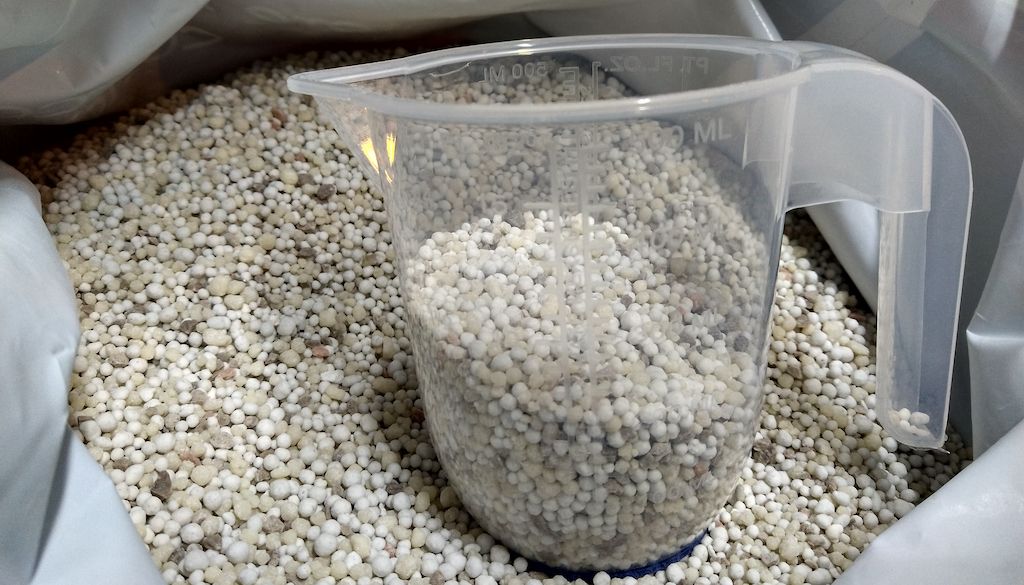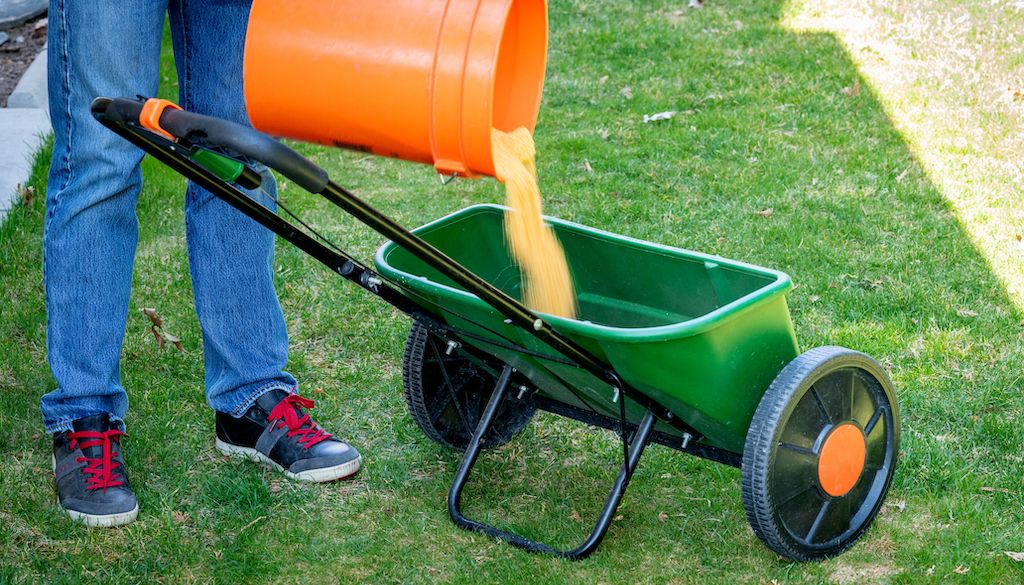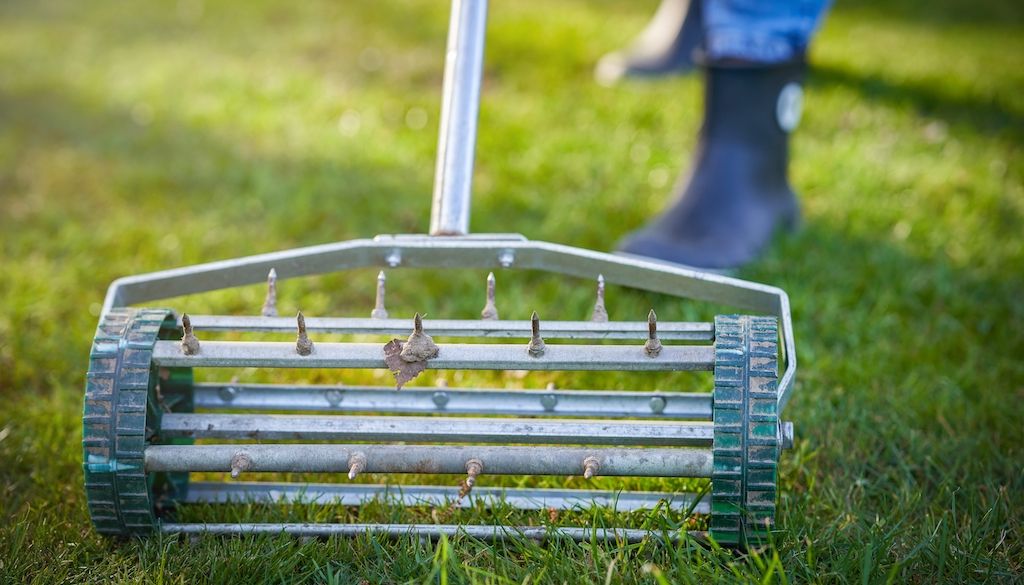Why is fertilizing your lawn important?
So, why should you fertilize your lawn to begin with? A fertilized lawn will foster healthy plant growth.
By enriching the soil with essential nutrients, fertilizers keep grass and other plants actively growing. Over time, you’ll see a noticeable difference in the vibrancy and color of the plants on a fertilized lawn. Depending on the type of fertilizer, it can also prevent weed growth and repel pests.
When to fertilize the lawn.
The best time of year to apply lawn food depends on the type of grass in your yard as well as the climate in your area.
Generally, you’ll want to time your fertilizer applications with periods of plant growth. For cool-season grasses, this is early spring and fall. Warm-season grasses, on the other hand, need fertilizer the most in early summer.
You may also want to conduct a soil test. A soil test will help you understand what types of nutrients and fertilizer your lawn needs.
Be sure to follow a regular fertilizer schedule. Plan to apply fertilizer at least twice a year, though required amounts may vary based on the time of year.
What you need to fertilize your lawn.
These are all the things you’ll need to fertilize your lawn:
- Grass fertilizer: Choose a product formulated for your specific grass type.
- Spreader: Use a broadcast spreader or drop spreader to distribute the fertilizer.
- Lawn aerator: If you have compacted soil, consider aerating it for the best results from your fertilizer.
- Protective gear: Wear gloves, safety glasses and a mask to protect yourself when handling lawn care products.
How to fertilize your lawn in 5 easy steps.
Whether you do it yourself or hire a pro, you should know how to fertilize a lawn. Here are a few important steps to follow:
Step 1: Choose the right fertilizer.
 Make sure you have all the tools you need and decide which type of fertilizer is best for your lawn.
Make sure you have all the tools you need and decide which type of fertilizer is best for your lawn.
Winterizer fertilizers and spring fertilizers will have different balances of nitrogen, phosphorus and potassium. You should also decide if you want a slow- or quick-release fertilizer. All of these factors will depend on the type of plant life in your yard.
Step 2: Gather your tools.
 Once you’ve researched your grass and fertilizer options, make sure you have everything you need.
Once you’ve researched your grass and fertilizer options, make sure you have everything you need.
For smaller lawns or lawns that only need fertilizer in certain areas, you may prefer a drop spreader or a handheld spreader. A broadcast spreader is ideal for covering large areas. You might also need a lawn aerator to prepare your soil to absorb the nutrients.
Step 3: Aerate your lawn if necessary.
 Aerating a lawn refers to the process of making small holes in the soil that allow water and air into it. You can use a rolling aerator or simply poke holes with a pitchfork.
Aerating a lawn refers to the process of making small holes in the soil that allow water and air into it. You can use a rolling aerator or simply poke holes with a pitchfork.
Aerating breaks up compacted soil that prevents plants from getting the water and nutrients they need. It’s usually best to aerate before fertilizing.
Step 4: Apply the fertilizer.
 Now it’s time to spread the fertilizer. Fill your spreader with the type of lawn food you have selected. Refer to the bag for the recommended amount. Spread the food evenly over your lawn.
Now it’s time to spread the fertilizer. Fill your spreader with the type of lawn food you have selected. Refer to the bag for the recommended amount. Spread the food evenly over your lawn.
For best results, try to maintain an even pace and not stop. This will help ensure you don’t overfertilize any areas, which can harm your lawn.
Step 5: Water the lawn.
 After spreading the fertilizer, water the lawn thoroughly. Watering helps the fertilizer penetrate beneath the grass so your soil absorbs the nutrients.
After spreading the fertilizer, water the lawn thoroughly. Watering helps the fertilizer penetrate beneath the grass so your soil absorbs the nutrients.
Lawn fertilizing mistakes to avoid.
If you choose to fertilize the lawn yourself, avoiding these pitfalls will help you get the job done right:
- Overfertilizing: Too much fertilizer can cause fertilizer burn, which discolors plants and damages the roots.
- Underfertilizing: Use too little fertilizer or fertilize too infrequently, and your plants won’t have the nutrients they need to thrive.
- Uneven application: If you don’t spread an even layer of fertilizer, some areas of your lawn may get fertilizer burn while others will wilt.
- Using the wrong type of fertilizer: Do your research before applying fertilizer, or you may be supplying your lawn with the wrong balance of nutrients.
- Fertilizing at the wrong time: When you should fertilize depends on the time of year, the type of grass and the minerals in your soil.
- Overwatering: Although your lawn needs water, too much can stifle growth and wash away fertilizer. It's also important to water slowly to avoid fertilizer runoff, which can damage the environment.
Hire a lawn care service on Thumbtack.
There are a lot of variables when it comes to fertilizing your lawn. You have to know your soil and your plants to select the best fertilizer. Knowing when to fertilize and how much also takes research and varies by situation. For the best results, it may be best to leave it to a lawn care professional.
Finding the best contractor in your area can be a challenge with so many options out there. The easiest way to hire a lawn care service is with Thumbtack. Download the Thumbtack app today to find the right contractor for your lawn.
Related: How much do lawn services cost?
FAQs
Should I water after fertilizing?
Watering the lawn after fertilizing is an essential step. Watering not only ensures the fertilizer reaches the soil but also helps the soil absorb it. Skipping this step can make it difficult for your plants to absorb the nutrients and lead to fertilizer burn.
Do you apply fertilizer to wet or dry grass?
It’s usually best to apply fertilizer to dry grass. Applying fertilizer to wet grass can also lead to fertilizer burn.
Wet grass absorbs the salts in fertilizer too quickly and loses too much moisture. Fertilizing dry grass also helps prevent it from clumping or washing away.
A note about project costs included or linked in this article: Figures represent national average cost estimates using data provided by Thumbtack pros and additional research. These figures are provided for educational purposes only and are subject to change at any time due to various factors. Details about your specific project and local rates can impact costs.
 After spreading the fertilizer, water the lawn thoroughly. Watering helps the fertilizer penetrate beneath the grass so your soil absorbs the nutrients.
After spreading the fertilizer, water the lawn thoroughly. Watering helps the fertilizer penetrate beneath the grass so your soil absorbs the nutrients.